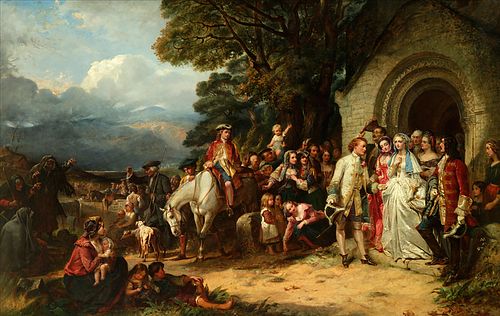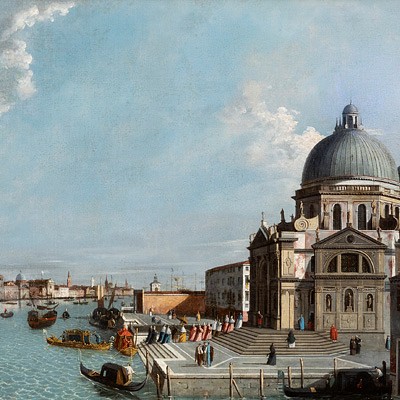THOMAS JONES BARKER (United Kingdom, 1815 - 1882). "The Marriage of Lammermoor's Bride", London, 1862. Oil on canvas. Signed in the lower right are
Lot 46
About Seller
Setdart Auction House
Carrer Aragó 346
Barcelona
Spain
Setdart Subastas was born in 2004 and is currently the first online art auction in Spain with solidity, prestige and reliability guaranteed by our more than 60,000 users. Setdart has a young, dynamic and enterprising team ready to successfully manage the purchase and sale of art works through custom...Read more
Estimate:
EUR€22,000 - EUR€25,000
$23,655.91 - $26,881.72
Absentee vs Live bid
Two ways to bid:
- Leave a max absentee bid and the platform will bid on your behalf up to your maximum bid during the live auction.
- Bid live during the auction and your bids will be submitted real-time to the auctioneer.
Bid Increments
| Price | Bid Increment |
|---|---|
| EUR€0 | EUR€10 |
| EUR€200 | EUR€25 |
| EUR€500 | EUR€50 |
| EUR€1,000 | EUR€100 |
| EUR€3,000 | EUR€200 |
| EUR€5,000 | EUR€500 |
| EUR€10,000 | EUR€1,000 |
| EUR€20,000 | EUR€2,000 |
| EUR€50,000 | EUR€5,000 |
About Auction
By Setdart Auction House
May 18, 2021
Set Reminder
2021-05-18 09:30:00
2021-05-18 09:30:00
America/New_York
Bidsquare
Bidsquare : Classics XIX and XX
https://www.bidsquare.com/auctions/setdart-auction-house/classics-xix-and-xx-6961
The next 18th May there will be a 19th and 20th Century Classics Auction at Setdart.com There will be a select repertoire of important artists such as Carlos Cruz Diez, Luis Feito, Joan Miró, Fernando Botero, Josep Llimona, Salvador Dalí among others. Setdart Auction House sofia@setdart.com
The next 18th May there will be a 19th and 20th Century Classics Auction at Setdart.com There will be a select repertoire of important artists such as Carlos Cruz Diez, Luis Feito, Joan Miró, Fernando Botero, Josep Llimona, Salvador Dalí among others. Setdart Auction House sofia@setdart.com
- Lot Description
THOMAS JONES BARKER (United Kingdom, 1815 - 1882). "The Marriage of Lammermoor's Bride", London, 1862. Oil on canvas. Signed in the lower right area. Signed, dated and located on the back. Attached study by Jorge Gutiérrez-García and Martínez de Marañón. With vintage frame. Measurements: 121 x 190 cm; 145 x 222 cm (frame). This work can be considered one of the best works of Thomas Jones Barker in its genre, both for its great quality and large format and for its complex composition, with numerous characters, the mastery in all aspects (landscape, quality of the canvases, etc.) and, especially, for the work of the characters, close to portraiture. There is no doubt about the authorship: the style coincides with that of Jones Barker, as well as the subject (a historical genre scene), and the work is signed "T.J. Barker pinxit" and, on the back, "Thomas Jones Barker pinxit, London 1862". On the other hand, the back of the work also presents several details that corroborate its authenticity. First of all, the stamps of the house in charge of making the stretcher and the canvas, which correspond to those used by the author (C. Davy Artists, 83 Newman st.). The date of the work, 1862, corresponds to the period in which this firm was located in Newman Street, Oxford (1843-1862). At the bottom of the frame we note a legend belonging to the framing workshop, J.M. Hill, active in the mid-19th century. Other labels and legends also appear, all corresponding to the period. Finally it should be noted that this work was sold at Christie's London in 1983, identified as a work by Jones Barker without doubt. "The Bride of Lammermoor" is a historical novel by Sir Walter Scott, published in 1819. It narrates the tragic love story between Lucy Ashton and Edgar Ravenswood, and the author indicates that it is based on real historical events that took place in the 17th century. Son of the painter Thomas Barker, Thomas Jones began his training with his father, and from 1835 he continued it in Paris with Horace Vernet, with whom he remained for many years. During these years in France Jones Barker frequently exhibited his works at the Paris Salon, being awarded three gold medals. He also painted several pictures for Louis Philippe of France, among them "The Death of Louis XIV". For Princess Marie, daughter of Louis Philippe, Jones Barker painted in 1840 "The Bride of Death", for which he received the Cross of the Legion of Honor. The painter returned to England around 1845, and soon began to exhibit his works at the Royal Academy in London, mainly portraits. He also sent to this institution a work inspired by a poem by Sir Walter Scott, "The Troubadour" (1849). As the years progressed, Jones Barker continued to show his works regularly at the Royal Academy, with different themes as his career evolved (war, historical works, portraits...). Probably following Vernet's influence, Jones Barker's first works mainly dealt with themes of the Napoleonic wars. Towards the end of his life he returned to war themes with great critical and public success, depicting themes of the Franco-Prussian and Crimean wars. He is currently represented in the National Portrait Gallery in London, the National Army Museum, the National Museum of Wales, the National Gallery of Ireland, the Southampton Art Gallery and the Maidstone Museum, among other public and private collections.
- Shipping Info
-
In-House Shipping
-
- Buyer's Premium



 EUR
EUR CAD
CAD AUD
AUD GBP
GBP MXN
MXN HKD
HKD CNY
CNY MYR
MYR SEK
SEK SGD
SGD CHF
CHF THB
THB


















